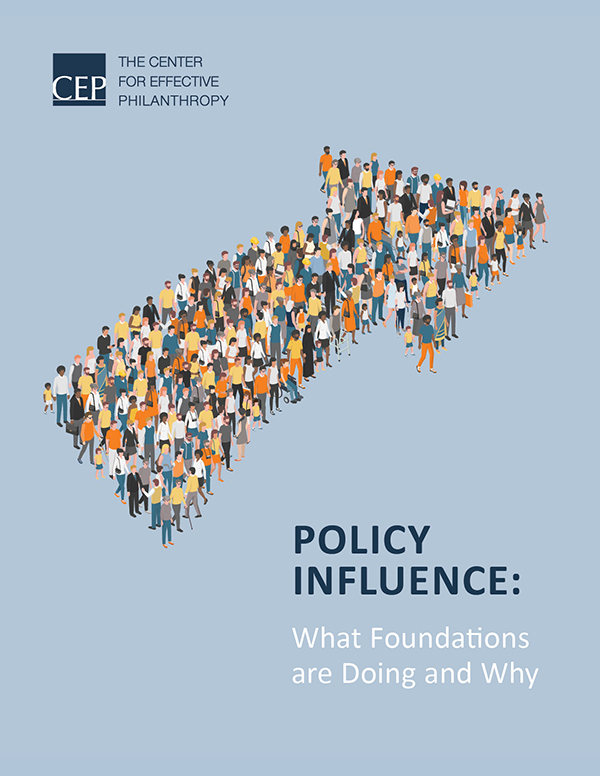
Public policy engagement is emerging as a crucial element of the philanthropic response to the COVID-19 crisis. It is especially timely, then, that new research out today from CEP sheds light on how foundations think about and approach their efforts to influence policy — and raises pressing questions about how to best move forward in a time when a policy-oriented response is especially relevant.
Funders are focusing on policy-related solutions as a part of crisis relief efforts right now in several ways.
Funders are making grants to support nonprofits’ COVID-19-related policy and advocacy efforts. Eight funders committed $7.1 million for the Families and Workers Fund to advocate for long-term policy efforts to reshape labor regulation. Wallace Global Fund announced grants “to advocate for stimulus packages that…reach underserved communities who are most vulnerable to COVID-19.”
Funders are also using their voices to advocate for policy responses to COVID-19. A Washington Post op-ed from Richard Besser, president and CEO of Robert Wood Johnson Foundation, advocates for “sick leave, universal health care, quality child care and early education, as well as fair immigration policies.” In an op-ed in the L.A. Times, Judy Belk, president and CEO of the California Wellness Foundation, writes about COVID-19’s disproportionate effect on black and brown communities and advocates for policy responses that put racial equity front and center.
And funders are collaborating with each other to influence policymakers’ decisions about relief measures. With leadership from Grantmakers Concerned with Immigrants and Refugees (GCIR), for example, more than 30 funders in California called on Governor Gavin Newson “to protect and support immigrant Californians as it considers important funding and policy decisions within the context of the Executive branch’s COVID-19 pandemic response.”
Separate from examples like these responding to the current crisis, philanthropic engagement in policy change is, of course, not new. Indeed, efforts to influence policy have been an essential part of many notable philanthropic achievements. Historical examples abound, from civil rights to public health, to name just a few.
Foundations’ involvement in policy change has not always been viewed positively, however. The role of foundations in influencing policy has been the subject of scrutiny and debate over the past century, and that discussion has only intensified in recent years.
For all the conversation and critique about foundations’ engagement in public policy, though, the sector-wide data about foundation practices in the public policy realm are limited.
CEP’s new report, titled Policy Influence: What Foundations are Doing and Why, explores the perspectives and practices of more than 200 leaders of community and private foundations across the country, including why and how funders seek to influence policy. It also shares the perspectives of more than 400 leaders of nonprofit organizations.
What came through loud and clear in the data is the strong belief among foundation leaders that public policy engagement has been — and continues to be — a crucial lever for change. Ninety percent of respondents report that their foundation engages in efforts to influence public policy.
Why is this work so important? Many foundation leaders believe that philanthropic engagement in public policy is an important way to achieve their goals, to ensure more effective grantmaking, and to pursue systems change. In the words of one foundation leader,
“It is surprising to me sometimes that foundations would imagine that they can do significant systems work without policy. If you think about the prevailing problems that we’re all facing, philanthropy is not going to grant its way out of the holes we’re in. Period. If you’re serious about doing something more than feel-good, you have to think ultimately about how the public sector will come to play a role in the solutions that you’re trying to develop.”
Despite growing debates in society at large about the influence of philanthropy on policy, foundations have increased their policy efforts. Still, for most funders, efforts to influence policy are a small portion of the work they do to achieve their programmatic goals.
Among other findings, the data in Policy Influence shows that:
- Working with others is the top recommendation foundation leaders give to those who are considering engaging in policy work, and 80 percent report they are part of collaborative efforts to influence policy. They emphasize the importance of aligning efforts, leveraging resources, sharing knowledge, and demonstrating broad support. As one respondent says, “Collaboration gives us more clout and a louder voice.”
- Half of the foundation leaders CEP interviewed think that, overall, their policy efforts have had mixed success. They underscore the challenging, non-linear nature of policy engagement, and some emphasize the importance of assessment in terms of contribution, not attribution.
- The most common challenge foundation leaders encounter in their policy work is building board support for their efforts. Only 45 percent of foundation leaders say their board is completely supportive of their foundation’s efforts to influence policy.
- Nonprofit leaders offer concrete suggestions for how foundations can better support their policy work — namely by funding more policy work and, given the time that progress in this arena can take, providing more flexible, longer-term grants.
CEP’s hope is that the findings in this study will help foundations approach their efforts to influence public policy more thoughtfully, which is all the more important now given the impact of the COVID-19 pandemic and accompanying economic crisis. For my colleagues and I who worked on this study, several key questions emerged from the research findings. We encourage funders to consider and candidly discuss the following with their staff, boards, and peers:
- Given that many foundation leaders believe that public policy plays a large role in goal achievement, why does policy engagement remain a small proportion of most foundations’ overall efforts?
- Given that many foundation leaders believe they cannot achieve their policy goals alone, how can they better support grantees’ policy efforts? Where can they build more effective partnerships with others, including other funders?
- Given that many foundation leaders believe that boards are the most common challenge in their policy work, how can they better educate and engage their board to build support?
- How can the nonprofit and philanthropic sector promote and engage in a more nuanced discussion about philanthropy and public policy influence?
CEP is grateful to the S. D. Bechtel, Jr. Foundation, Robert Wood Johnson Foundation, the Brainerd Foundation, the McKnight Foundation, New Hampshire Charitable Foundation, Rockefeller Brothers Fund, and Wilburforce Foundation for funding this research.
Naomi Orensten is director, research, at CEP.


